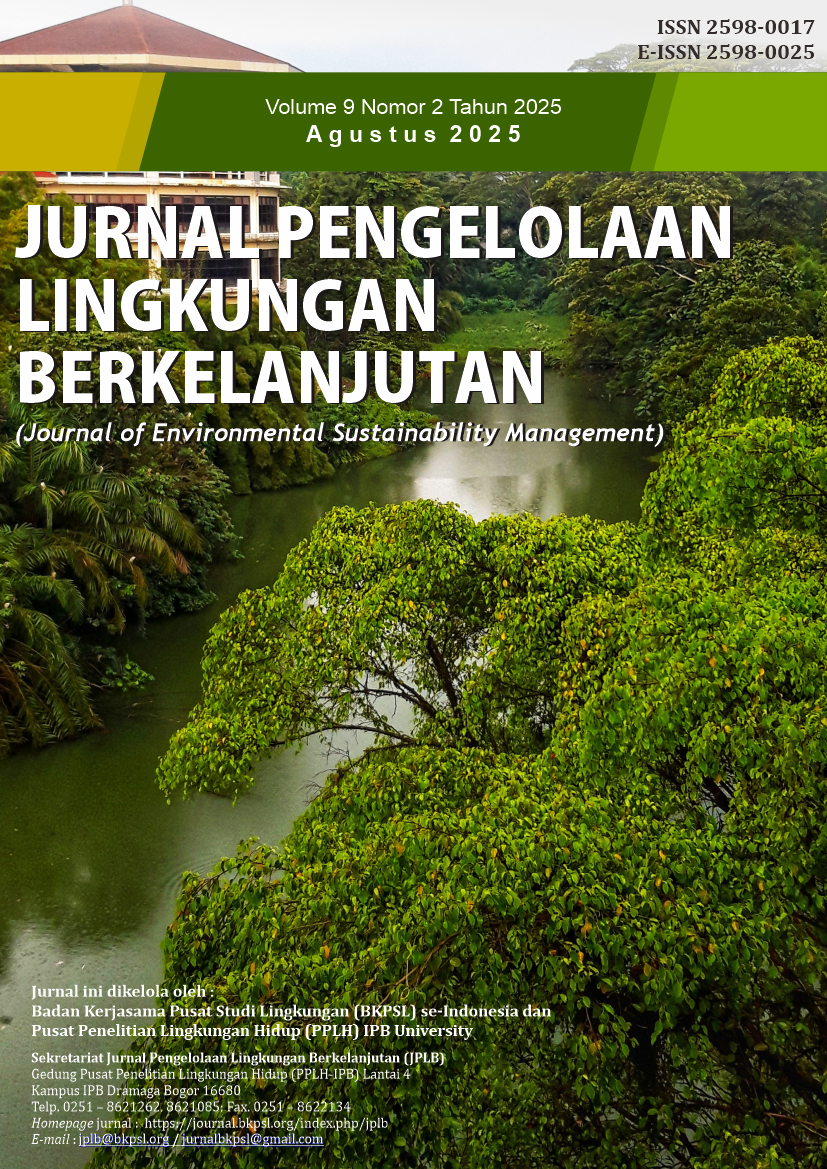Livelihood adaptation strategies of the community in Sukajadi during the COVID-19 pandemic: non-farm or farm?
Abstract
The COVID-19 pandemic caused severe disruptions to the economy through mobility restrictions and business closures, resulting in job losses and forcing workers and entrepreneurs to adapt. This study explores livelihood strategies in Sukajadi Village, West Java, where most residents are employed in non-farm sectors and a smaller proportion in farming. A mixed-method approach was applied, combining observations, in-depth interviews and household surveys. Data was collected between February and June 2022, with follow-up in February 2024. Findings reveal generational differences in livelihood choices: older residents remain engaged in horticultural farming, while younger generations prefer non-farm employment, particularly in the garment sector. During the “second wave” of the pandemic (May–July 2021), two types of garment industries (garment manufacturing and made-to-order clothing) faced challenges, but the made-to-order sector proved more resilient. This was due to more flexible order systems, fewer workers, higher sewing skills and lower dependence on centralized markets. Although farming persists as an option, limited agricultural resources and a lack of farming skills make non-farm sectors more favourable. Overall, these findings suggest that in the face of economic disruption, people's adaptation strategies tend to be directed towards non-agricultural work rather than agricultural work which requires greater skills and resources.
Downloads
References
Bashar A, Hasan NA and Haque MM. 2024. Exploring sustainable livelihood options for COVID-impacted rural communities in Bangladesh. Heliyon 10(19):1-13. https://doi.org/10.1016/j.heliyon.2024.e38664
Berdegué JA, Proctor FJ and Cazzuffi C. 2014. Cities in the rural transformation. RIMISP Working Group: Development with Territorial Cohesion, Territorial Cohesion for Development Program. Santiago.
Bharata IBAY. 2024. Dampak Pandemi COVID-19 terhadap dinamika perekonomian wilayah di Provinsi Bali. Jurnal Geografi 20(1):18-26.
Bista R, Parajuli R, Giri K, Karki R and Song C. 2022. Impacts of COVID-19 pandemic on the livelihoods of rural households in the community forestry landscape in the Middle Hills of Nepal. Trees, Forests and People 9: 100312. https://doi.org/ 10.1016/j.tfp.2022.100312.
[BPS] Badan Pusat Statistik Kabupaten Bogor. 2021. Tamansari Sub-district Dalam Angka 2021. BPS Kabupaten Bogor. Bogor.
Breman J and Wiradi G. 2004. Masa cerah dan masa suram di pedesaan Jawa: studi kasus dinamika sosio-ekonomi di dua desa menjelang akhir abad ke-20. LP3ES. Jakarta.
Creswell JW. 2014. Research Design Qualitative, Quantitative and Mixed Method Approaches (4th ed.). Sage Publication Inc. California.
Eryando T, Sipahutar T and Rahardiantoro S. 2020. The risk distribution of COVID-19 in Indonesia: a spatial analysis. Asia Pacific Journal of Public Health 32(8):450–452. https://journals.sagepub.com/doi/pdf/10.1177/1010539520962940
Fatimah D, Asriani DD, Zubaedah A and Mardhiyyah M. 2020. Ora obah, ora mamah: studi kasus gender pada sektor informal di masa pandemi COVID-19. Friedrich-Ebert-Stiftung (FES) Jakarta. Jakarta.
Jason LA and Glenwick DS. 2016. Handbook of Methodological Approaches to Community-Based Research: Qualitative, Quantitative and Mixed Methods. Oxford University Press. Oxford.
Kuleh Y, Ilmi Z and Amin Kadafi M. 2022. The intensity of agriculture in the COVID-19 from Indonesia – a systematic literature review. Journal of Agriculture and Crops 8(2):94–104. https://doi.org/10.32861/jac.82.94.104
McGee T and Firman T. 2000. Labour market adjustments in Indonesia. Singapore Journal of Tropical Geography 21(3):316–335. https://onlinelibrary. wiley.com/doi/10.1111/1467-9493.00084
Merenkova I, Agibalov A and Zakupnev S. 2020. Modelling of diversified development of rural areas [Proceeding]. Proceedings of the International Conference on Policies and Economics Measures for Agricultural Development (AgroDevEco 2020).
Njurumana GN, Ngongo Y, Octavia D, Suharti S, Rakatama A, Prameswari D, Maharani R, Wibowo LR, Tampubolon AP, Suratman, Dewi R, Hadi EEW, Adalina Y, Basuki T, deRosari B and Hendarto KA. 2025. Livelihood resilience of forest-dependent farmers amidst the COVID-19 pandemic in Sikka, Indonesia. Sustainable Futures, 9:1-14. https://doi.org/10.1016/j.sftr.2025.100533
Olivia S, Gibson J and Nasrudin R. 2020. Indonesia in the time of COVID-19. Bulletin of Indonesian Economic Studies 56(2):143–174.
Pitoyo AJ, Aditya B, Amri I and Rokhim AA. 2021. Impacts and strategies behind COVID-19 induced economic crisis: evidence from informal economy. Indian Journal of Labour Economics 64(3):641–661. https://doi.org/10.1007/s41027-021-00333-x
Putra RA, Ajie T, Widyani SSN, Prayuda D, Trapsila TA and Agustina NS. 2023. Tjia Kang Hoo: menyelisik nilai-nilai pembina kehidupan masyarakat etnis Tionghoa muslim di Jakarta Timur. Innovative: Journal of Social Science Research 3(6), 4397–4415. https://j-innovative.org/index.php/Innovative/article/view/6736
Setiawan MF. 2020. Tamansari Bogor masuk zona merah COVID-19 [internet]. Available at: https://www.antaranews.com/berita/1435716/tamansari-bogor-masuk-zona-merah-COVID-19
Sitko N, Knowles M, Viberti F and Bordi D. 2022. Assessing the impacts of the COVID-19 pandemic on the livelihoods of rural people. FAO. Rome. https://doi.org/10.4060/cb7672en
Sudiro KLK. 2024. Ancaman resesi global pasca pandemi COVID-19 dan dampaknya terhadap ketahanan konsumen di Indonesia: pendekatan analisis sintesis. Journal of Economic Resilience and Sustainable Development 1(1):32-46. https://doi.org/10.61511/ersud.v1i1.2024.638
Suryahadi A, Izzati RA and Suryadarma D. 2020. The impact of COVID-19 outbreak on poverty: an estimation for Indonesia. The SMERU Research Institute. Jakarata. https://www.smeru.or.id/sites/default/files/publication/wp_COVID19impact_draft.pdf
Tenda ED, Asaf MM, Pradipta A, Kumaheri MA and Susanto AP. 2021. The COVID-19 surge in Indonesia: what we learned and what to expect. Breathe 17(4):1-5. https://doi.org/10.1183/20734735.0146-2021

This work is licensed under a Creative Commons Attribution 4.0 International License.






_mini_size.jpg)








_10241.png)



